West Midlands Police
West Midlands Police is the territorial police force responsible for policing the metropolitan county of West Midlands in England.
| West Midlands Police | |
|---|---|
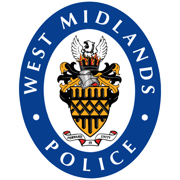 | |
| Abbreviation | WMP |
| Motto | Forward in Unity |
| Agency overview | |
| Formed | 1 April 1974 |
| Preceding agencies |
|
| Employees | 10,884[1] |
| Volunteers | 2,000 |
| Annual budget | £452.6 million[2] |
| Legal personality | Police service |
| Jurisdictional structure | |
| Operations jurisdiction | West Midlands county, England, United Kingdom |
.svg.png) | |
| Jurisdictional area shown within England | |
| Size | 348 mi²[3] |
| Population | 2.83 million[3] |
| Legal jurisdiction | As per operations jurisdiction |
| Constituting instrument | |
| General nature | |
| Operational structure | |
| Headquarters | Lloyd House, Colmore Circus Queensway, Birmingham[4] 52°29′01″N 1°53′50″W |
| Constables | 6,656 (additionally 303 are special constables)[5] |
| Police Community Support Officers | 506[1] |
| Police and Crime Commissioner responsible | |
| Agency executive |
|
| Parent agency | Home Office |
| Child agency | |
| Neighbourhood Policing Units | 8 |
| Facilities | |
| Stations | 52[7] |
| Airbases | Birmingham Airport[8] |
| Helicopters | 1 Eurocopter EC135[8] |
| Website | |
| www | |
Covering an area with nearly 2.9 million inhabitants, which includes the cities of Birmingham, Coventry, Wolverhampton and also the Black Country; the force is made up of 6,495 Police Officers (10.9% are BAME in September 2019). In 2014 there were 7,162 officers, 611 (8.5%) are from a BAME background,[9] supported by 3,131 Police Staff, 188 (down from 303) Special Constables[10] and 506 Police Community Support Officers (PCSO) – with these 10,884 employees, this makes it the third largest force in England and Wales behind the Metropolitan Police and Greater Manchester Police; and the fifth-largest force in the United Kingdom after Police Scotland and Police Service Northern Ireland (PSNI).
The force is currently led by Chief Constable Dave Thompson. The force area is divided into ten Local Policing Units (LPUs), each being served by four core policing teams – Response, Neighbourhood, Investigation and Community Action & Priority (CAPT) – with the support of a number of specialist crime teams. These specialist teams include CID, traffic and a firearms unit who provide a twenty-four-hour availability to attend reported incidents involving the use of firearms and knives.
From comparative data published by Her Majesty's Inspectorate of Constabulary for the twelve months up to September 2013, West Midlands Police recorded 62.93 crimes per 1000 population against an average for England and Wales of 61.39. Total recorded crime was down 3% on the same period the previous year against an average of a 3% fall nationally. Detection rates for the same period were 23% against a national average of 29% and victim surveys indicated 84.76% of victims were satisfied with overall service provided by West Midlands Police compared against a national average of around 85%.
West Midlands Police is a partner, alongside Staffordshire Police, in the Central Motorway Police Group. The force is party to a number of other resource sharing agreements including the National Police Air Service.
History
Regional policing in the West Midlands prior to 1974
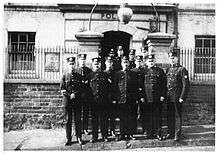
Prior to the formation of West Midlands Police as it is known today, the area now covered by the force was served by a total of six smaller constabularies. These constabularies were as follows:
- Birmingham City Police 1839–1974: Established in 1839 following an outbreak of Chartist rioting that the Metropolitan Police had to help quell, officers from Birmingham City Police first took to the streets on 20 November of that year.[11] Initially with a strength of 260 officers paid at a rate of 17 shillings a week,[11] the constabulary expanded to keep pace with the growth of the city with the final areas to be added before the force's amalgamation in West Midlands Police being the Hollywood area.[12]
- Coventry Police 1836–1974: Formed with the Municipal Corporations Act in 1836, Coventry Police was initially only twenty officers with the support of a single sergeant and one inspector.[11] The force reached a strength of 137 officers by 1914 and continued to grow until in 1969 it was merged with the Warwickshire and Coventry Constabulary, part of which it remained until the formation of West Midlands Police.
- Dudley Borough Police 1920–1966: Formerly part of the Worcestershire Constabulary, Dudley gained its own police force on 1 April 1920 following a review by His Majesty's Inspector that had suggested previous policing arrangements were unsatisfactory.[13] Dudley Borough Police remained independent until the Royal Commission in 1960 which resulted in its inclusion as part of the newly formed West Midlands Constabulary.
- Walsall Borough Police 1832–1966: Moving away from a 'watch' system, Walsall Borough Police were formed on 6 July 1832 with an initial strength of only one superintendent and three constables.[14] As with the other regional forces, Walsall Borough Police expanded with the area's population and in 1852 appointed its first two detectives. The force took on its first female recruits in 1918 and in the 1960s became one of the first forces to issues its officers with personal radios. As with Dudley's police force, Walsall Borough Police became part of the West Midlands Constabulary following the Royal Commission.
- West Midlands Constabulary 1966–1974: Lasting only eight years, West Midlands Constabulary was a newly formed force encompassing a number of smaller borough forces including Dudley Borough Police, Walsall Borough Police, Wolverhampton Borough Police and parts of Staffordshire and Worcestershire Constabularies.[15] The creation of the West Midlands Constabulary was the consequence of 1960's Royal Commission into policing.
- Wolverhampton Borough Police 1837–1966: The formation of Wolverhampton Borough Police was approved on 3 August 1837 under the condition that the strength of the force not exceed sixteen men.[16] The Police Act 1839 saw Staffordshire County Police taking over policing in Wolverhampton with Wolverhampton Borough Police regaining responsibility for policing the town in 1848. At the turn of the 20th century the force was 109 strong, reaching a highpoint of around 300 before the force became part of the short lived West Midlands Constabulary in 1966.
Establishment of West Midlands Police
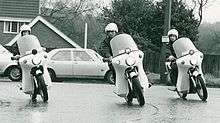
West Midlands Police was formed on 1 April 1974, owing to the provisions of the Local Government Act 1972 which created the new West Midlands metropolitan county. It was formed by merging the Birmingham City Police, the earlier West Midlands Constabulary, and parts of Staffordshire County and Stoke-on-Trent Constabulary, Warwickshire and Coventry Constabulary and West Mercia Constabulary. The first Chief Constable appointed to the new force was Sir Derrick Capper, the last Chief Constable of Birmingham Police.
Controversies and allegations of corruption
Between 1974 and 1989, the force operated the West Midlands Serious Crime Squad. It was disbanded after allegations of endemic misconduct, leading to a series of unsafe convictions. These included allegations that officers had falsified confessions in witness statements, denied suspects access to solicitors and used torture such as "plastic bagging" to partially suffocate suspects in order to extract confessions. They were alleged to have abused payments to informers. A series of around 40 prosecutions failed in the late 1980s as defendants showed that evidence had or may have been tampered with. West Yorkshire Police led an investigation which led to a small number of internal disciplinary proceedings, but did not recommend any prosecutions for lack of evidence. However, over 60 convictions secured from their investigations have now been quashed, including those of the Birmingham Six.[17]
West Midlands Police had two serious firearms incidents, in 1980 and 1985. In 1980, David Pagett held his pregnant girlfriend as hostage while resisting arrest by the police. Officers returned fire, and shot her.[18] Police had initially tried to claim that Pagett has shot her, but it became clear that it was police bullets that had caused her death. In 1985, John Shorthouse was arrested by West Midlands police for questioning about armed robberies in South Wales. His house was then searched. His five-year-old son, John, was shot by police searching under the child's bed. An internal inquiry was held, and as a result, use of firearms was restricted to a specialised and trained unit.[19]
Allegations of bribery and corruption were made in 1994 by World in Action. The convicted criminal David Harris alleged that West Midlands police officers had demanded payments of more than £200,000 to keep criminals including himself away from prosecutions. Other allegations from police officers focused on officers attempting to persuade others to accept bribes. The CID was the focus of an investigation by Leicestershire Police at the request of the Police Complaints Authority.[20]
2000s and onwards
Under proposals announced by the then Home Secretary, Charles Clarke, on 6 February 2006, West Midlands Police would have merged with Staffordshire Police, West Mercia Constabulary and Warwickshire Constabulary to form a single strategic force for the West Midlands region.[21] This, along with a number of other mergers which would have cut the number of forces in England and Wales from 43 to 24, were abandoned in July 2006 after widespread opposition from police and the public.[22]
Because of the prisons' overcrowding crisis in Birmingham in October 2006 three dozen police cells are to be made available to house inmates in Birmingham to help ease congestion. (By contrast, one contemporary account reported, in 1833, that for days the city gaol had been entirely empty.[23]) Despite a dip in the number of prisoners that month, prisons in the region are close to capacity or already full. Between 32 and 44 cells were set aside at Steelhouse Lane police station, in Birmingham City Centre, in case of emergency. West Midlands Police has an established agreement with HM Prison Service to provide cells in the event they are needed.[24]
In October 2008, the Chief Constable Sir Paul Scott-Lee announced he would not be renewing his contract in May 2009, after seven years in the post. His replacement is Chris Sims.[25]
On taking office, the new Chief Constable announced that the force would be realigned to exist alongside council boundaries, abolishing the Operational Command Units (OCUs) and reforming as Local Policing Units (LPUs). In April 2010, the force reorganised from 21 OCUs into ten new LPUs.[26] There were also changes to the HQ departments, including the new Local Policing Department, the new Public Protection Department and Force CID (formerly Crime Support). These changes were introduced as part of 'Program Paragon' with the aim of making savings for the force of around £50 million.[27]
The aim is to move certain functions from local areas into the central departments – such as dealing with complex or serious crimes, along with finance, IT and administration tasks, so that the local policing units can concentrate on local policing issues. There is also the long-term aim of reducing the number of Contact Management Centres from ten (one each for each LPU) to one, covering the whole of the force.
The force attracted controversy in 2010 when Project Champion, a £3 million scheme to install a network of CCTV cameras in the predominantly Muslim areas of Washwood Heath and Sparkbrook, came under fire from local residents and civil rights organisations.[28] A total of 218 cameras had been planned for installation but the project was abandoned following concerns over their legality and objections from residents and local councillors that they had not been consulted by the force.[29]
Owing to the Government's Comprehensive Spending Review, the force has been required to make savings totalling £126 million over a four-year period.[27] Projects including Continuous Improvement and Priority Based Budgeting (PBB) have been established to identify where such savings can be made with a variety of options explored.[30]
The force is one of many to implement Regulation A19, requiring officers with thirty year's service to retire and have made redundancies for police staff ranks.[31] The force had been exploring Business Partnering options involving working with private companies but this plan was halted by Bob Jones, the force's first Police and Crime Commissioner, upon him taking office.[32]
In July 2014 West Midlands PCC agreed to a £25m contract with Accenture[33][34]
Leadership and performance
West Midlands Police is smaller than at any previous time in its history having lost nearly 2,300 officers since 2010. David Jamieson said, West Midlands Police was, "inundated by violent crime" and the homicide team was at "breaking point". "It's extremely difficult to see how we can sustain what the public would call an acceptable level of policing, [and due to pressure on the force] things that frankly the public expect from the police are just not being done in the quality that people would expect". Crime is increasing in the area and also the type of crime that is increasing, like sexual crime and terrorism needs a great deal of police time. Government funding for West Midlands Police fell by £145 million since 2010. Caroline Spelman maintains the West Midlands is a hotspot for terrorism and the police need more resources to deal with new forms of crime. 999 calls in the West Midlands are 74% above average for England and Wales. Jamieson fears without higher police funding the criminals will win. Chief constable, Dave Thompson maintains falling numbers of police officer and a, "wider spread of crime" prevent the police doing everything the public want or expect of them. Thompson was asked if recent funding cuts to the police put the public into danger, he replied, “I think that’s the inescapable conclusion. (...) You know, we have far fewer officers, we’re not able to deal with all the incidents we could deal with. It’s a deadly equation, isn’t it?” Preet Gill said that concerns of victims were not being met.[35][36][37]
Command Team
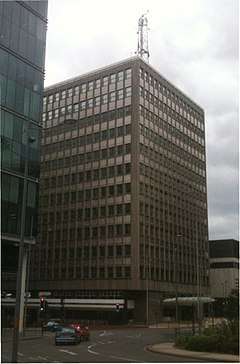
West Midlands Police is managed by a Command Team who are based at the force's Lloyd House headquarters in Birmingham. They work alongside an elected Police & Crime Commissioner who sets the budget and priorities for the force. The Command Team are able to participate in respective LPU Daily Management Meetings by utilising a video conferencing system.[38]
The West Midlands Police Command Team is currently composed of six officers and three civilian staff:[39]
| Chief Constable | Dave Thompson[40] | Overall strategic charge of force |
| Deputy Chief Constable | Louisa Rolfe[41] | Second in command to Chief Constable |
Numerous changes have occurred and the most up to date information is shown on WMP's website:[39]
Chief Constables
- Sir Derrick Capper (April 1974- June 1975)[42]
- Philip Knights (August 1975 – 1985)[43]
- Sir Geoffrey Dear (1985–1990)[44][45]
- Sir Ron Hadfield (June 1990 – July 1996)[46]
- Sir Edward Crewe (August 1996 – c. September 2002?)[45][47]
- Sir Paul Scott-Lee (October 2002 – April 2009)[48]
- Chris Sims (1 June 2009 - January 2016)[49]
- Dave Thompson (January 2016-)
Police and Crime Commissioner
Crime statistics and budget
The following two tables show data recorded for financial year ending March 2019 on recorded crime compared against the total for England and Wales (including West Midlands Police.)[50]
| Data Set | Criminal damage and arson | Drug offences | Fraud Offences | Miscellaneous crimes | Possession of weapons offences | Public order offences | Robbery | Sexual offences | Theft offences | Violence against the person | Total |
|---|---|---|---|---|---|---|---|---|---|---|---|
| West Midlands Police | 25957 | 4790 | No Data | 3909 | 2534 | 14821 | 8744 | 7450 | 115270 | 76186 | 259661 |
| England and Wales | 573577 | 151471 | 693418 | 103138 | 46196 | 447896 | 85736 | 162030 | 2015998 | 1671039 | 5950499 |
| Data Set | Criminal damage and arson | Drug offences | Fraud Offences | Miscellaneous crimes | Possession of weapons offences | Public order offences | Robbery | Sexual offences | Theft offences | Violence against the person |
|---|---|---|---|---|---|---|---|---|---|---|
| West Midlands Police | 10% | 1.84% | No Data | 1.51% | 0.98% | 5.71% | 3.37% | 2.87% | 44.39% | 29.34% |
| England and Wales | 9.64% | 2.55% | 11.65% | 1.73% | 0.78% | 7.53% | 1.44% | 2.72% | 33.88% | 28.08% |
The following table shows data recorded in the twelve months up to September 2013 on recorded crime and anti-social behaviour (ASB), quality of service, finances and workforce numbers for West Midlands Police compared against average data from England and Wales' 43 police forces:[51]
| Data Set | West Midlands Police | Average for England and Wales | Force Ranking |
|---|---|---|---|
| Recorded crime and ASB per 1000 population | 62.93 | 61.39 | 11/43 |
| Percentage of victims satisfied with overall service provided by the police | 84.76 | 85.20 | 31/43 |
| Total cost of policing of head of population | 218.68 | 216.44 | 6/43 |
| Workforce (full-time equivalent) per 1000 population | 4.27 | 3.88 | 3/43 |
The following table shows recorded crime for West Midlands Police by offence group for the year ending September 2013:[52]
| Total (Including fraud) | Violence against the person | Sexual offences | Robbery | Burglary | Offences against vehicles | Other theft offences | Fraud and forgery | Criminal damage | Drug offences | Other offences | |
|---|---|---|---|---|---|---|---|---|---|---|---|
| West Midlands Police | 173,053 | 31,687 | 2918 | 5404 | 24,400 | 23,000 | 20,688 | 632 | 24,848 | 7716 | 2184 |
| England and Wales | 3,725,281 | 604,174 | 59,466 | 61,836 | 453,428 | 382,461 | 1,885,983 | 201,035 | 518,382 | 200,640 | 42,785 |
The following table shows the percentage change in recorded crime for West Midlands Police by offence group for the year ending September 2013 compared against the year ending September 2012:[52]
| Total (Including fraud) | Violence against the person | Sexual offences | Robbery | Burglary | Offences against vehicles | Other theft offences | Fraud and forgery | Criminal damage | Drug offences | Other offences | |
|---|---|---|---|---|---|---|---|---|---|---|---|
| West Midlands Police | -3 | 10 | 5 | -10 | -7 | -2 | -12 | -76 | -7 | -12 | -6 |
| England and Wales | -3 | -2 | 17 | -10 | -4 | -3 | -9 | 34 | -9 | -8 | -2 |
The following table shows the percentage detection rates for West Midlands Police by offence group for 2012/2013:[53]
| Total | Violence against the person | Sexual offences | Robbery | Burglary | Offences against vehicles | Other theft offences | Fraud and forgery | Criminal damage | Drug offences | Other offences | |
|---|---|---|---|---|---|---|---|---|---|---|---|
| West Midlands Police | 23 | 32 | 28 | 24 | 9 | 8 | 19 | 14 | 10 | 91 | 60 |
| England and Wales | 29 | 41 | 29 | 21 | 13 | 11 | 21 | 22 | 16 | 94 | 69 |
The following table shows the West Midlands Police & Crime Commissioner Finances in millions of pounds for 2014-15 compared with 2013-14:[54]
| Year | Employees | Premises | Transport | Supplies & services | Gross expenditure | Income | Net expenditure | Use of reserves | Net budget requirement |
|---|---|---|---|---|---|---|---|---|---|
| 2014-15 | 467.66 | 22.24 | 7.79 | 45.05 | 553.55 | -24.41 | 553.42 | -9.86 | 543.56 |
| 2013-14 | 491.63 | 22.10 | 9.06 | 43.81 | 578.75 | -21.96 | 559.02 | 2.35 | 556.67 |
Dave Thompson stated that unforeseen pensions expenses of £8.6m in 2019 and £13.9m in 2200, from a budget of £514m cost roughly as much as 500 officers and would lower the total number of officers to 6,000, contrasted with 8,600 in 2010. Thompson added, “There is no question there will be more obvious rationing of services. The public can already see it is going on. We are already not pursuing crimes where we could find a suspect. We are doing things now that surprise me. We are struggling to deliver a service to the public. I think criminals are well aware now how stretched we are. These further cuts will leave us smaller than we have ever been. There is unquestionably more demand than there was in 1974.”[55]
Structure and departments

Local Policing Units
The area covered by West Midlands Police is divided into ten Local Policing Units (LPUs). Each LPU is headed by a Chief Superintendent who is responsible for the overall policing and management of the area. He or she is supported by a Local Command Team (LCT) composed of a varying number of Superintendents and Chief Inspectors.[56]
Each LPU has a number of dedicated Neighbourhood Policing teams. These cover a specific area and are headed by a sergeant with support from a number of police officers, PCSOs and sometimes special constables. The force operates a number of police stations.
The ten LPUs are:
| LPU | Neighbourhoods | Stations (LPU HQ in bold) |
|---|---|---|
| Birmingham West LPU (Ladywood & Perry Barr) |
Birmingham City Centre, Broad Street Entertainment Area, Southside, Aston, Ladywood, Nechells, Soho, Handsworth Wood, Lozells and East Handsworth, Oscott, Perry Barr, Digbeth, Small Heath and Jewellery Quarter[57] |
|
| Birmingham South LPU (Bournville, Edgbaston, Selly Oak & Northfield) |
Bartley Green, Woodgate, Edgbaston, Harborne, Quinton, Kings Norton, Longbridge, Northfield, Weoley, Billesley, Bournville, Brandwood and Selly Oak[58] |
|
| Birmingham East LPU (Hodge Hill, Yardley & Hall Green, Alum Rock & Washwood Heath) |
Hall Green, Moseley and Kings Heath, Sparkbrook, Springfield, Bordesley Green, Hodge Hill, Shard End, Washwood Health, Acocks Green, Sheldon, South Yardley and Stechford and Yardley North[59] |
|
| Coventry LPU |
St. Michael's, Foleshill, Henley, Longford, Lower Stoke, Upper Stoke, Wyken, Bablake, Holbrook, Radford, Sherbourne, Whoberley, Woodlands, Binley and Willenhall, Cheylesmore, Earlsdon, Wainbody and Westwood[60] |
|
| Dudley LPU |
Castle and Priory, Coseley East, Gornal, Sedgley, St. James's, St. Thomas's, Upper Gornal and Woodsetton, Brierley Hill, Brockmoor and Pensnett, Kingswinford North and Wall Heath, Kingswinford South, Netherton, Woodside and St. Andrews, Wordsley, Belle Vale, Halesowen North, Halesowen South, Hayley Green and Cradley South, Amblecote, Cradley and Wollescote, Lye and Stourbridge North, Norton, Pedmore and Stourbridge East, Hagley, Quarry Bank and Dudley Wood, Wollaston and Stourbridge Town[61] |
|
| Sandwell LPU |
Blackheath, Bristnall, Cradley Heath and Old Hill, Langley, Sandwell, Old Warley, Oldbury, Rowley, Tividale, Abbey, Smethwick, Soho and Victoria, St. Pauls, Friar Park, Great Bridge, Princes End, Tipton Green, Wednesbury North, Wednesbury South, Charlemont with Grove Vale, Great Barr with Yew Tree, Greets Green and Lyng, Hateley Heath, Newton and West Bromwich Central[62] |
|
| Solihull LPU |
Bickenhill, Blythe, Castle Bromwich, Chelmsley Wood, Dorridge and Hockley Heath, Kingshurst and Fordbridge, Knowle, Meriden, NEC, Smith's Wood, Elmdon, Lyndon, Olton, Shirley East, Shirley South, Shirley West, Silhill and St. Alphege[63] |
|
| Walsall LPU |
Aldridge North and Walsall Wood, Aldridge Central and South, Brownhills, Pelsall, Rushall, Shelfield, Pheasey Park Farm, Streetly, Bloxwich East, Bloxwich West, Birchills Leamore, Blakenall, Bentley and Darlaston North, Darlaston South, Short Heath, Willenhall North, Willenhall South, Paddock, Palfrey, Pleck and St Matthews[64] |
|
| Wolverhampton LPU |
Wolverhampton City Centre, Bushbury North, Bushbury South and Low Hill, Fallings Park, Heath Town, Oxley, Wednesfield North, Wednesfield South, Bilston East, Bilston North, Blakenhall, East Park, Ettingshall, Spring Vale, Graiseley, Merry Hill, Park, Penn, St. Peter's, Tettenhall Regis and Tettenhall Wightwick[65] |
|
LPU Local Command Team Structure
Each LPU is run by a Local Command Team (LCT) consisting of a Chief Superintendent supported by a number of Superintendents & Chief Inspectors. Each member of the LCT has assigned responsibility for specific elements of policing and are organised according to the following structure:[56]
| Indicative LPU Command Team | ||||||||||||||||||||||||||||||||||||||||||||||||||||||||||||||||||||||||||||||||||||||||||||||||||||||||||||||||||||||||||||||||||||||||||||||||||||||||||||||||||||||||||||||||||||||||||||||||||||||||||||||||||||||||||||||||||||||||||||||||||||||||||||||||||||||||||||||||||||||||||||||||||||||||||
|---|---|---|---|---|---|---|---|---|---|---|---|---|---|---|---|---|---|---|---|---|---|---|---|---|---|---|---|---|---|---|---|---|---|---|---|---|---|---|---|---|---|---|---|---|---|---|---|---|---|---|---|---|---|---|---|---|---|---|---|---|---|---|---|---|---|---|---|---|---|---|---|---|---|---|---|---|---|---|---|---|---|---|---|---|---|---|---|---|---|---|---|---|---|---|---|---|---|---|---|---|---|---|---|---|---|---|---|---|---|---|---|---|---|---|---|---|---|---|---|---|---|---|---|---|---|---|---|---|---|---|---|---|---|---|---|---|---|---|---|---|---|---|---|---|---|---|---|---|---|---|---|---|---|---|---|---|---|---|---|---|---|---|---|---|---|---|---|---|---|---|---|---|---|---|---|---|---|---|---|---|---|---|---|---|---|---|---|---|---|---|---|---|---|---|---|---|---|---|---|---|---|---|---|---|---|---|---|---|---|---|---|---|---|---|---|---|---|---|---|---|---|---|---|---|---|---|---|---|---|---|---|---|---|---|---|---|---|---|---|---|---|---|---|---|---|---|---|---|---|---|---|---|---|---|---|---|---|---|---|---|---|---|---|---|---|---|---|---|---|---|---|---|---|---|---|---|---|---|---|---|---|---|---|---|---|---|---|---|---|---|---|---|---|---|---|---|---|---|
| ||||||||||||||||||||||||||||||||||||||||||||||||||||||||||||||||||||||||||||||||||||||||||||||||||||||||||||||||||||||||||||||||||||||||||||||||||||||||||||||||||||||||||||||||||||||||||||||||||||||||||||||||||||||||||||||||||||||||||||||||||||||||||||||||||||||||||||||||||||||||||||||||||||||||||
Core Policing Teams
West Midlands Police is structured in such a way that there are four key teams in each LPU who have the responsibility for dealing with everyday policing duties.[66] The force's current structure was gradually introduced over the past two years with the Solihull and Birmingham South LPUs being the first area to see the change in June 2011[67] and the Walsall LPU being the last in January 2013.[68] The structural change was introduced as part of the force's 'Continuous Improvement' program with the ambition of working in a more cost effective and efficient manner and was overseen under the advice of accounting firm KPMG.[67]
Prior to Continuous Improvement, the force had operated with larger response and neighbourhood teams and smaller teams allocated to prisoner handling roles. Community Action & Priority Teams were a new addition to the force's structure under Continuous Improvement.
The core policing teams are:
Community action and priority teams (CAPT)
The 'CAPT' support neighbourhood officers to address local issues and resource demands for service not met by other departments. They can be allocated to neighbourhoods suffering particular issues, for example anti-social behaviour, and are also often Public Order trained, so are used for policing football matches, demonstrations and similar occasions.[69] As with the Investigation Teams, the Community Action & Priority Teams are supervised by a sergeant who reports to an inspector.
Key responsibilities of community action and priority teams are as follows:[69]
- Supporting Neighbourhood Teams – Providing specialist support to Neighbourhood Teams for example, conducting drugs warrants or addressing anti-social behaviour.
- Addressing local issues – Supporting other front line policing teams and completing tasking as directed by LPU Local Command Teams
- Providing support for abstractions – Resourcing abstractions such as football matches, demonstrations and similar incidents so that Neighbourhood officers are able to focus on their beats.
Investigation teams
Officers on Investigation Teams have three main responsibilities, these being secondary investigation, prisoner handling and attending scheduled appointments with the public.[70] These officers are also responsible for completing prosecution files and other paperwork necessary for taking cases to court. Investigation teams are split into a number of shifts, each supervised by a sergeant, and will have an inspector supervising the sergeants.
Key responsibilities of Investigation Teams are as follows:[70]
- Secondary investigation – Following initial attendance of incidents by Response Team officers, investigations are allocated to Investigation Teams who conduct any follow up enquiries that are required.
- Prisoner handling – Offenders arrested by Response and Neighbourhood officers are handed to Investigation Teams who will interview and retain ownership of the investigation up to the point of its conclusion.
- Scheduled response – Operating on a diary system, Investigation Team officers attend pre-booked slots with members of the public who are wanting to report none urgent matters.
Neighbourhood teams
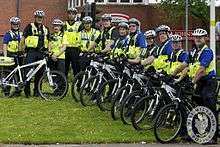
Aligned to specific neighbourhoods, these officers seek to tackle long term issues affecting local areas and attend community meetings. There are one hundred and seventy one neighbourhoods across the West Midlands[3] and officers assigned to neighbourhood teams are often supported by PCSOs and Special Constables. It is not uncommon for busier areas, such as town centres, to have several neighbourhood teams such as the St. Matthews beat covering Walsall Town Centre which has two teams.[71] Neighbourhood teams usually have a single sergeant who reports to a sector inspector.
Force Response
Response officers work in shifts around the clock answering the most urgent calls for service received through the force's call centres. It is not unusual for response officers to work alone and each response shift usually has a number of officers who are authorised to carry Taser.[72] In addition to Taser, some response officers also carry mobile fingerprint ID machines to confirm identities at the roadside.[73] Response officers undergo enhanced driving training and also have a range of other skills required to perform their role including 'method of entry' training so that they can force entry into premises. Many Response officers are also public order trained in order to respond to spontaneous disorder should it occur. Response teams are supervised by a number of sergeants and an inspector.
Key responsibilities of Response Teams are as follows:
- Primary investigation – Attending incidents in the first instance, Response officers gather available evidence and record offences. Follow up enquiries are then allocated to the Investigation Teams.
- Missing person enquiries – Response officers conduct investigations into missing persons with a low or medium risk assessment.
- Traffic – Officers from Response Teams attend reported Road Traffic Accidents, sometimes supporting Force Traffic in the case of serious collisions.
Specialist crime teams
The core policing teams are supported by, and work closely with, a number of specialist crime teams.[74] West Midlands Police had a mounted division which was disbanded in 1999 to divert funds elsewhere, the former stables on Pershore Road, Birmingham, now house the driving school.[75] Current specialist crime teams include:
Air operations
.jpg)

| Wikimedia Commons has media related to West Midlands Police helicopters. |
The Midlands Air Operations Unit is a consortium of West Midlands, Warwickshire, West Mercia and Staffordshire Police which is based at Birmingham Airport and has operated since 25 July 1987.[77]
After experimenting, since the 1970s, with civilian helicopters hired on an occasional basis,[78] West Midlands Police launched their own air unit on 10 May 1989 with G-WMPA, an Aérospatiale AS355 F2.[77] G-WMPA was subsequently fitted with a gyro-stabilised camera turret with daytime and thermal image cameras, plus a Nitesun Searchlight and Skyshout PA System.[79] It was sold to a buyer in Switzerland in 2007.[80] From January 2000 they operated G-WMID, a MD902 "NOTAR" helicopter,[81] named "Miss Mollie Collins",[82] after a child who had "shown tremendous courage in dealing with her disability",[83] in a local newspaper competition.[82] This aircraft was subsequently re-registered as G-KSSH and is the Surrey air ambulance.[84] In July 2007 G-WMID was replaced by a Eurocopter EC135 P2+, G-WMAO.[85] G-WAMO was destroyed by arson in the early hours of 8 June 2009, while at Birmingham Airport.[86] From October 2009 to July 2010, they used a Eurocopter EC135 T1, G-SUFF,[87] loaned by the manufacturer.
They now operate another Eurocopter EC135 P2, G-POLA, acquired in July 2010.[88] The EC135 offers a range of capabilities including high definition thermal video recording, a microwave downlink to send images to control rooms, a 30 million candlepower spot light and an enhanced navigation system.[89]
All of the above helicopters have had a casualty evacuation role[90] for occasions when a Midlands Air Ambulance was unable to attend meaning that they are able to carry a patient in a stretcher for transport to hospital.[91]
Under the terms of the National Police Air Service, a helicopter is available as a resource for use by neighbouring forces and in turn, West Midlands officers can call upon other forces' helicopters should their own be unavailable.[92]
Airport policing
The West Midlands Police force area includes Birmingham Airport which is on the Solihull LPU,[93] but not Coventry Airport which is on the Warwickshire Police force area and so policed by their own officers.[94] Birmingham Airport has a dedicated airports policing team assigned who work closely with HM Customs and Excise and UK Visas and Immigration officials.[95] Officers working at the airport have additional powers under the Terrorism Act 2000 as the airport is 'designated' under the terms of the Act[96] and some are armed.
Central Motorway Police Group (CMPG)
West Midlands Police is one of the two police forces who contribute officers to the Central Motorway Police Group, the others being Staffordshire Police.[97] CMPG operate out of three main bases, the main headquarters being under the M6 motorway at Perry Barr at which their central control room and vehicle depot is situated.[98] CMPG also have a regional control centre in Quinton, Birmingham shared with the Highways Agency.[99] Officers attached to CMPG cover a wide geographical area, including in the West Midlands the M6, M54 and A45.[97]
Counter terrorism unit (CTU)
Based in Birmingham, the counter terrorism unit (CTU) is responsible for co-ordinating the force's counter terrorism activity in the West Midlands region. CTU works under the guidance of the Government's national counter terrorism strategy, CONTEST, with the aims of pursuing terrorists, protecting the public, preparing for a possible attack and preventing terrorism by working in the community to address the causes of terrorist activity.[100]
As part of the CTU's role in working with the community, its structure includes a Prevent Team which is a group of officers who visit schools, community groups and partner agencies to raise awareness about the work on the unit. Exercises include Act NOW, a tabletop exercise explaining what happens during a counter terrorism operation and WRAP (Workshop to Raise Awareness of Prevent), a presentation aimed at front line public sector workers and organisations that work with potential victims of radicalisation.[101]
Dog Section
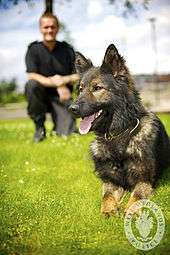
Most dogs in the West Midlands Police Dog Section are products of an in-house breeding program which the force has been running at its Balsall Common training centre since 1994.[102]
Specialist search dogs including Springer Spaniels and Labradors are also used by the Dogs Unit to locate drugs or firearms and explosives. Dogs are continually recruited from rescue centres and from members of the public. All specialist dogs are handled by officers who already have a general purpose police dog, giving the handler responsibility in both training and operational deployment.[103]
There are currently 69 operational dog handlers working in West Midlands Police, and dogs undergo an initial training program lasting twelve weeks.[104] Officers with the Dog Section patrol in specially adapted Skoda patrol vehicles with air conditioned cages capable of carrying up to three dogs in the rear[105] and operate from bases at Aston, Canley and Wednesbury.[106]
Events planning and football
The events planning department has responsibility for co-ordinating large-scale events taking place within the force area and also for ensuring that officers are available should they be required to support other regional forces through mutual aid arrangements.[107] One major responsibility of the department is organising the policing operation for the Autumn political party conferences that are often held at the International Convention Centre in Birmingham City Centre. Included within this department also is the Football Unit who coordinate policing of football games within the West Midlands and operate a team of 'spotters' to identify violent supporters and banned individuals.[108]
The policing of large-scale events such as football matches, VIP visits and public demonstrations can be coordinated from the force's Events Control Suite (ECS) at the Tally Ho facility in Birmingham. The ECS is able to receive live CCTV footage and has computer facilities for the use of partner agencies with whom the suite is shared.[109]
Firearms
West Midlands Police operate a number of Armed Response Vehicles (ARVs) that patrol the region around the clock and are available to respond to incidents typically involving guns, knives or dangerous dogs.[110] Officers undertake a ten-week selection process to join the firearms unit with courses being delivered on weapons, tactics and advanced driving. Most of the ARVs used by the firearms unit are unmarked Audis, converted with the rear seats removed and gun safes installed.[111] Officers with the firearms unit carry Taser X26 stun guns, SIG P229 9mm pistols, H&K MP5 SF A2/A3 9mm semi-automatic carbines and H&K G36K SF, G36C SF and SIG Sauer SIG516[112] 5.56mm semi-automatic rifles.[113]
Alongside attending firearms incidents, officers attached to the firearms unit also provide tactical advice when planning operations and give lectures on firearms awareness to officers and members of the public.[110] The force also has a Firearms Licensing Department which is responsible for the issue of shotgun and firearms certificates to members of the public and explosives certificates to companies requiring them.[114]
Force CID
Detached from the LPUs, Force CID is staffed by officers holding a detective qualification and investigate serious and complicated crimes not taken on by Local CID or other departments. Such offences include murders, serious assaults, blackmail and arson. Force CID is arranged into a series of Major Investigation Teams and work from bases at Bloxwich, Harborne, Aqueous 2 (Aston) and Willenhall in Coventry.[115]
Working within Force CID are a series of Payback Teams who are responsible for arranging asset seizures and confiscations under the Proceeds of Crime Act. During 2011 offenders were forced to pay back £6.3 million from proceeds of crime, a 39% increase on the previous year.[116]
Force traffic
Based at Park Lane, Chelmsley Wood and Wednesbury,[117][118] the force traffic unit has responsibility for roads policing on all roads inside the West Midlands other than the motorways which are covered by the Central Motorways Policing Group. Officers from the force traffic unit usually hold advanced driving grades and have access to a range of high-powered marked and unmarked vehicles, including BMWs and Audis fitted with evidential video recording equipment. Force Traffic is supported by a Collision Investigation Unit based at Aston Police Station who investigate accidents involving fatalities or life-changing injuries.[117]
Forensic scene investigators (FSI)
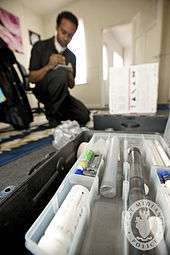
Officers are supported by a team of civilian forensics scene investigators approximately one hundred strong who attend crime scenes and examine seized items to obtain forensic evidence for use in court.[119] Formerly known as scenes of crime officers (SOCO), scene investigators have access to a wide range of specialist equipment to help with their role and alongside gathering forensic samples; they also are responsible for crime scene photography.
Intelligence unit
West Midlands Police has dedicated intelligence cells based on each LPU who collate and disseminate information collected by officers from a range of other sources. This role involves 'sanitising' intelligence logs and forwarding them on to relevant persons, receiving information from outside sources such as Crimestoppers, and assisting with the progression of investigations.[120]
The intelligence unit is responsible for organising briefing material for officers and police leadership; they also include a covert operations unit, who coordinate undercover policing operations under the terms of the Regulation of Investigatory Powers Act 2000 (RIPA).
West Midlands Police is a partner alongside Warwickshire Police, West Mercia Police and Staffordshire Police in the Regional Intelligence Unit collaborative working agreement under which information is shared between the forces on serious and organised criminals affecting the West Midlands Region.[121]
Integrated emergency management (IEM)
The Operations Integrated Emergency Management service is responsible for ensuring that the force is ready to respond to major incidents, that business continuity plans are in place and that the force's duty under the Civil Contingencies Act 2004 is satisfied.[122] This work includes running exercises and drills to test readiness and working closely with other emergency services and local authorities. As part of the service's work, the force also maintains a number of Casualty Bureau facilities at which calls from the public are taken and collated following a major incident such as a plane crash or terrorist attack.[123]
Local CID
Each LPU has a Local CID team of officers who hold a detective qualification and conduct secondary investigations into serious offences that occur within their area. Offences that fall under the remit of Local CID include burglary of dwellings, personal robberies, frauds and some vehicle crime.
Offender management unit (OMU)
All ten LPUs have an offender management unit (OMU) who work with partner agencies to concentrate on the offenders living on their areas identified as being particularly difficult or damaging. Offenders who fall into this category include those designated as prolific and other priority offenders (PPOs), drug users, violent criminals and young criminals.[124]
Officers from the OMU manage their assigned PPOs under two strands. One consists of rehabilitation and resettlement under which partner agencies are involved in an effort to halt re-offending whilst the other consists of catching and convicting offenders who have been identified as not participating in rehabilitation programmes or are wanted for outstanding crimes.[124]
Operational support unit (OSU)
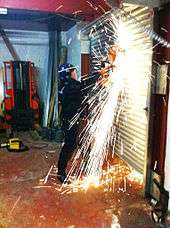
Working from Park Lane, Chelmsley Wood and Wednesbury Stations,[125] the operational support unit is a team of officers specially trained in areas including Public Order policing, method of entry and searching.[126] Officers working with the OSU are typically deployed as part of a 'serial' of one sergeant and seven officers and have access to a host of specialist equipment and vehicles including armoured land rovers.
Public protection unit (PPU)
The public protection unit (PPU) investigates reports of sexual assaults and incidents involving children and vulnerable people. PPU is split between adult and child investigations, is responsible for safeguarding and works with partner agencies such as social services and domestic violence charities.[127] As with CID, most officers working in the PPU hold a detective qualification.
Safer travel
The safer travel team is a collaboration between West Midlands Police, the British Transport Police and CENTRO focussing on criminal activity occurring on the public transport network.[128] The team is composed of officers and PCSOs who patrol trains, buses and trams in the region.
The Partnership, the first of its type in the country, also has access to around 1,000 CCTV cameras which are located at bus, rail and metro stations, park and ride sites and in bus shelters.[129] The dedicated control centre is staffed 24 hours a day to spot and respond to incidents.[129]
Professional standards department (PSD)
Based at Lloyd House, the professional standards department have the responsibility for the recording and assessment of all public complaints, whether they are made about police officers, police staff or special constables. PSD also has a role in investigating serious reports of misconduct and corruption involving members of the force.
Members of the public are eligible to make a complaint if they are the person who the behaviour about which they want to complain about was directed towards, if they were ‘adversely affected' by said behaviour or if they were an eyewitness to said behaviour.[130] A person is 'adversely affected' if he or she suffers any form of loss or damage, distress or inconvenience, if he or she is put in danger or is otherwise unduly put at risk of being adversely affected.
PSD work alongside the Independent Office Police Conduct (IOPC), to whom they will refer the most serious allegations.[130]
Where appropriate, PSD have a range of outcomes following disciplinary panels, including no action, counselling (management advice), written warning, transfer to another post, withholding increments and dismissal.[131]
West Midlands Police recorded 1536 complaints for 2011/12, an 18% drop in comparison to 2010/11 during which 1871 complaints were recorded.[132]
Press Office
Also known as Corporate Communications, the West Midlands Police Press Office is centralised at headquarters and is charged with representing the force's public image. Staff working in the Press Office are the first point of contact between the media and the force, they organise press releases, press conferences and complete a range of other public relations functions.[133] Each LPU has dedicated Territorial Communications officers and in addition to addressing media enquiries, the Press Office also looks after the force's website and publishes the force's internal online newspaper, News Beat.
Social media
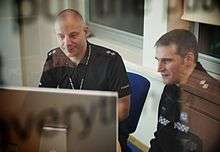
West Midlands Police maintains a presence on a variety of social media websites including Twitter, Facebook, Flickr, YouTube and blogging platforms.[134] Each LPU has a dedicated Facebook and Twitter account, with more than 200 departments, officers, PCSOs and special constables also tweeting from officially endorsed accounts.[134]
The force has used various social media accounts to promote its activity in a variety of ways including running photo competitions,[135] holding live web chats with senior officers[136] and hosting live tweeting events from operations.[137]
Several of the force's social media accounts have won recognition as examples of best practice, including Solihull Police's Twitter feed which came first place in the 2012 Golden Twits' Customer Service category[138][139] and Inspector Brown's Mark Hanson Digital Media Award 2012 for his mental health blog.[140]
Special constabulary
Officers belonging to the special constabulary have the same powers as full-time officers and are unpaid volunteers, giving a minimum of sixteen hours a month of duty time.[141]
Initial training for special constables lasts 22 weeks, and when deployed they wear the same street uniform as other officers. They can be identified as Specials by their collar numbers, which start with 7 and the 'SC' on their epaulettes.
Special constables provide West Midlands Police with around 96,000 hours of voluntary duty each year and usually work alongside regular officers on neighbourhood teams, response teams[142] and also Community Action & Priority Teams.[69]
Recruitment and training
Applicants to join West Midlands Police as police officers are subject to a staged recruitment process designed to assess their suitability for the role. The process consists of the following steps:
- Application form: The first stage of the application process is a paper sift assessing applicants' competency. Unsuccessful applicants are required to wait six months before reapplying.[143]
- Assessment centre: The assessment centres involves written tests measuring candidates' English and maths, a series of exercises involving role playing actors and a twenty-minute competency based interview.[144]
- Background checks: All applicants to have passed the assessment centre are subject to a series of enhanced background checks examining both their security and financial history.[145]
- Medical: Applicants are required to undergo eyesight and hearing tests, a general medical assessment and submit hair samples for drugs testing.[146]
- Fitness test: The final stage of the application process is a fitness test involving completing one circuit of an activity course within three minutes and forty five seconds and a twenty-second test on a push-pull machine.[146]
On being accepted to join the force, new recruits undergo an initial training course last eighteen weeks which is non-residential and based mainly in the classroom but with periodic practical exercises and attachments. Performance is assessed by a series of examinations and training includes self-defence lessons and tuition on police computer systems. Following successful completion of initial training, recruits are then tutored on their LPUs for nine weeks before being signed off for independent patrol. They retain their status as student officers for a period of two years from their joining date during which they are required to maintain a record of their development. Upon reaching two years service, student officers are 'confirmed' in their rank by a senior officer, usually their LPU commander.
The recruitment process for PCSOs is similar to that of police officers although training periods are reduced. The recruitment of police staff varies according to the role.
West Midlands Police has not received any new police officers or PCSOs since midway through 2010, the recruitment freeze owing to the need to make budget cuts.[147]
On the 11th June 2020 West Midlands Police and Crime Commissioner David Jamieson committed to ensuring that the force recruits 1,000 new BAME police officers over the next three years to make the force look more like the communities it serves.[9]
Racism and sexism in promotions controversy
In November 2018 it emerged that the police force had blocked white male officers from promotion, setting aside half of all promotion slots for women and ethnic minority candidates in seven out of eight of the year's promotion rounds. In the year's final round the force continued to discriminate, by blocking white male applicants for two days. A complaint by the Police Federation union noted that the practice was illegal and condemned it as "not fit for purpose". As a result West Midlands Police "paused" the practice.[148]
Presentation
Police officers working for West Midlands Police have access to a wide range of different uniforms, equipment and vehicles dependent of their specific role.
Headgear

West Midlands Police officers wear the traditional black custodian helmet in the rose style, with seamed joined and thin black metal band with a Brunswick star that reads 'West Midlands Police'.[149] Female officers wear a black bowler hat with Sillitoe tartan banding for foot patrol and mobile patrol.[149] Traffic officers wear a white peaked cap with Sillitoe tartan banding, or a white bowler with Sillitoe tartan banding hat for mobile patrol,[150] as do officers holding inspector rank or above although their caps are black rather than white.[151]
PCSOs always wear a peaked cap with a blue band, or a bowler hat with a blue band for female PCSOs, and all officers, whether Constable or PCSOs, when travelling on bicycle wear a black cycle helmet with 'Police' inscribed on it.[152]
Armed Response or Dog Section officers wear black protective baseball caps that read 'Police' and have a Sillitoe tartan pattern on the sides[153] whilst motorcycle officers and Air Operations officers wear specialised hard helmets with in-built radio microphones.[154]
Uniform
Officers' standard street uniform consists of black lightweight zip-up shirts, black trousers and a high visibility protective vest. White shirts were replaced by the black T-shirts in 2010 at a cost of £100,000 but are retained for court and station duties.[155] Officers are issued with fleeces, weatherproof pullovers, fluorescent jackets, high visibility tabards, waterproof over trousers and slash resistant gloves.
Aside the standard street uniform, there are a variety of additional uniforms issued to officers performing specialist roles. Public Order trained officers wear two piece fire retardant overalls and boots with additional body armour and NATO helmets,[156] whilst those with the Cannabis Disposal Team wear one piece jumpsuits and hard hats.[157] Officers working with the OSU searching teams are issued thicker winter coats and tie cord trousers.[158]
Ranks & epaulettes
Shoulder insignia for ranks above police constable are as follows:
- West Midlands Police warranted officer ranks
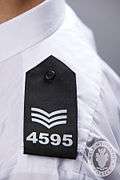 Sergeant
Sergeant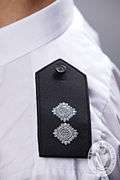 Inspector
Inspector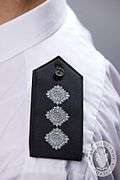 Chief Inspector
Chief Inspector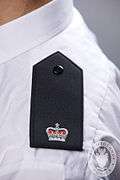 Superintendent
Superintendent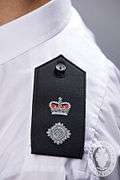 Chief Superintendent
Chief Superintendent Assistant Chief Constable
Assistant Chief Constable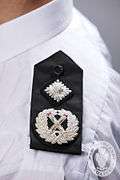 Deputy Chief Constable
Deputy Chief Constable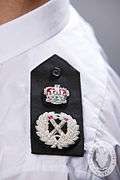 Chief Constable
Chief Constable
When dressed for public order policing, officers wear coloured epaulettes indicating their respective roles. Bronze commanders wear yellow epaulettes, inspectors wear red epaulettes, sergeants wear white epaulettes, tactical advisors wear blue epaulettes, medics wear green epaulettes and evidence gathering officers have orange epaulettes.[159]
Collar numbers within West Midlands Police are between two and five numbers long. Prior to 2006 collar numbers were up to four numbers in length, the numbering system was altered in 2006 to accommodate proposed changes that would have been introduced by a merger of local forces. Officers to have joined since 2006 have five figure collar sequential numbers starting with a 2, PCSOs have collar numbers starting with a 3, police staff have collar numbers starting with a 5, special constables have collar numbers starting with a 7 and transferees from other forces have collar numbers starting with 29.
Equipment
As part of standard issue Personal Protective Equipment (PPE), officers carry Sepura TETRA radios, rigid handcuffs, CS spray and an extendible friction lock baton.[160] Officers also have access to first aid kits, limb restraints and torches.[161]
Officers have access to a huge range of additional equipment for specialist operations, some of which requires training before it can be used.
In terms of 'method of entry' equipment, main stations usually have a store in which is kept battering rams,[162] pulley bars, hydraulic presses, ladders and even circular saws for cutting away bars.[163]
Traffic units, particularly officers performing collision investigation duties, use laser plotting devices to accurately survey collision sights and carry devices that can be used to measure road friction and deceleration values.[164]
Forensic teams can call for the deployment of tents to cover crime scenes, lighting rigs, stepping plates and a host of other items required to help them preserve evidence. Laboratories have installed drying cabinets, microscopes and sampling equipment for the securing and analysis of specimens.
Vehicles
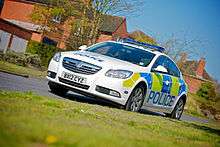
The standard marked patrol vehicle for response and neighbourhood officers has been the Vauxhall Astra although these are gradually being phased out in favour of automatic Vauxhall Insignias. A number of Peugeot 308, Peugeot Expert cage vans, LDV Maxus cage vans and Ford Focus vehicles are included in the fleet also.[165] All of these vehicles are modified for police usage with radios installed, lights, sirens and a 'run lock' facility enabling officers to take the keys out of the ignition without stopping the engine running, thereby ensuring the battery isn't depleted if the lights need to left on for long periods.[166]
.jpg)
For routine patrol and 'scheduled responder' duties, there are a number of marked Vauxhall Corsas in the fleet.[167] There are also unmarked and largely unmodified Astras and Insignias for use by non-uniform departments such as CID.
Force Traffic have a range of marked and unmarked patrol vehicles, all modified with the same equipment as response vehicles but with the addition of ANPR/HD video cameras, data terminals and accurately calibrated speedometers. Vehicles used include the BMW 3 series, BMW 5 Series and Volvo S60.[165] Motorbikes used include the BMW R1200RT[168] and Yamaha FJR.[169] Motorway patrols are conducted by the CMPG in marked Jaguar XF vehicles.[170]
Firearms units tend to use the unmarked Audi A6 and marked BMW X5 which are modified with gun cabinets, radios and bullet proof plates.[165] Dog Units have assigned Škoda Octavia Estate vRS vehicles with air conditioned cages built into their boot.[165]
For public order duties, West Midlands Police use Iveco Daily vans with equipment racks in the rear for the storage of shields and other public order equipment.[165] Armoured Land Rover Defenders are also available for public order situations.[171]
West Midlands Police Fleet Services also has a range of specialist recovery vehicles including the Iveco Flatbed Trucks[165] and portable custody vans.[172]
Driving grades
There are three different levels of driving grade within West Midlands Police which are as follows:[173]
- Basic driver: Officers with a basic driver grade are able to drive marked and unmarked vehicles but are not allowed to exceed speed limits or use the lights and sirens. The basic driver course lasts around half a day.
- Standard driver: The standard driver grade allows officers to exceed the speed limit by up to 20 mph and conduct the initial stages of a pursuit providing it is safe to do so. The standard driver course is three weeks long.
- Advanced driver: Drivers holding an advanced grade are able to drive higher performance vehicles at speeds above the extra 20 mph granted to standard drivers and receive additional training in pursuits and specialist techniques such as making a silent approach towards incidents. The advanced driver course is four weeks long.
Further to the above grades, the driver development school also provides bolt on courses relating to driving police carrier vehicles, four by fours and VIP escort skills.
Facilities

There are currently 52 police stations in the West Midlands Police force area situated across the 10 LPUs alongside a number of other facilities housing specialist crime teams and support services not open to the public. Only one police station is open 24/7, 365 days a year and is located at Lloyd House, with a separate public entrance. Most of the few police stations open to the public have limited opening hours and generally are shut by 10pm.[174][7]
The force headquarters is Lloyd House on Colmore Circus Queensway, Birmingham City Centre, and houses the Command Team alongside other departmental offices including the Press Office and Professional Standards Department.
The NPAS helicopter operates from a base at Birmingham Airport in Solihull which has facilities including motorised hangar doors, reinforced steel pedestrian access, an alarm system and CCTV to provide the helicopter protection whilst on the ground.[175]
Large scale policing demonstrations such as protest marches and football matches are coordinated from the Events Control Suite (ECS) in Birmingham. Alongside radio facilities and the ability to stream live footage from the force helicopter, the ECS also has shared space for partner agencies.[109]
Public Order courses are hosted at the regional training centre which consists of a converted aircraft hangar on the RAF Cosford site near Telford. The site has facilities allowing officers to experience riot situations including dealing with 'Emotionally Disturbed Person' scenarios during which they are subject to attacks by role playing actors wielding weapons.[176]
Custody Suites
As of October 2010 there were 18 custody suites designated under PACE for the reception of detainees.[177] Not all of these custody suites are currently used by the force, most have been mothballed owing to budget restraints and have been replaced by two planned 'super blocks', each with sixty cells @ Perry Barr and Oldbury.[177] Other current custody suites are as follows: Bournville (B'ham South) 17 cells and Coventry Central (Little Park Street 26 cells and Chace Avenue, Coventry for terrorism cases only.[177]
During an overhaul of the CCTV systems used in the force's custody suites that was completed in 2011 at a cost of £2.5 million, a networked range of audio and visual recording equipment was installed allowing staff to monitor detainees for the purposes of ensuring their safety and furthering investigations.[178] Footage is recorded to RAID storage devices with a total capacity of 1400 terabytes.
West Midlands Police operate a Custody Visiting Scheme under which independent representatives from local communities are able to access detention facilities to observe, comment and report upon the welfare and treatment of detained persons.[179] Visits are conducted at random by volunteers working in pairs who then write a report on the feedback gathered during their visit.[180]
In 2017 a joint inspection of the force's custody suites was conducted by HMIC and Her Majesty's Chief Inspector of Prisons.[177]
West Midlands Police Federation
The West Midlands Police Federation is a part of the Police Federation of England and Wales, which is the representative body for every Police officer below the rank of Superintendent. Representatives of the Federation are elected for three year terms and must be serving police officers.[181]
Police officers are restricted by their regulations from striking and from taking part in politics, hence the Federation represents their interests and negotiates on their behalf in the Police Negotiating Board in relation to pay, conditions and pensions.
The Federation is funded by a monthly subscription paid from officers' salaries and provides representation and advice to officers who are subject to disciplinary offences. Each LPU has Police Federation Workplace representatives to whom officers can go to for support.[182]
West Midlands Police Benevolent Fund
The West Midlands Police Benevolent Fund was set up in 1974 following the amalgamation of local forces to form West Midlands Police. The fund is financed by subscriptions from members and donations from a wide variety of sources and monies are distributed on application to the committee to both serving and retired officers who are subscribing members and who find themselves suffering financial hardship and in need of assistance.[183]
Police officers are able to subscribe to the Benevolent Fund for a subscription of £2 a month[184] and are eligible to receive a range of charitable grants and loans at the discretion of the Management Committee.[185]
West Midlands Police Sports & Social Club
The West Midlands Police Sports & Social Club is a subscription based club offering members access to a wide range of discounted goods and services including hotels, attractions and meals.[186] The club runs a monthly lottery with a £5000 jackpot open not only to all serving police officers, PCSOs and staff but also to retired employees.
A wide range of sporting clubs operate through the club including athletics, walking, shooting and fishing. The club owns a minibus which can be booked out for members' use and members are able to apply for grants from the club to subsidise the cost of events.
Officers killed in the line of duty
.jpg)
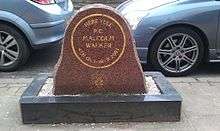
The Police Roll of Honour Trust lists and commemorates all British police officers killed in the line of duty, and since its establishment in 1984 has erected over 38 memorials to some of those officers.
The following officers of West Midlands Police and its former constabularies are listed by the Trust as having died attempting to prevent, stop or solve a crime, since the turn of the 20th century:[187]
- 1901: PC Charles Phillip Gunter. Fatally injured by thrown brick while attempting to disperse a disorderly crowd
- 1925: PC Albert Willits. Shot dead while attempting to arrest three men
- 1928: PC Charles William Sheppard. Beaten to death attending a disturbance
- 1965: DS James Stanford QPM. Fatally stabbed; posthumously awarded Queen's Police Medal
- 1975: PC David Christopher Green. Fatally stabbed during an arrest
- 1984: PC Andrew Stephen Le Comte. Fell from a roof while searching for suspects
- 1984: PC Colin John Hall. Collapsed attending a disturbance and died
- 1988: PC Gavin Richard Carlton. Shot by armed robber during a police pursuit
- 1989: PC Anthony John Salt. Fatally injured by falling on a mechanical digger after getting drunk on duty[188][189]
- 2001: PC Malcolm Edward Walker. Fatally injured when his motorcycle was struck during a police pursuit
- 2004: DC Michael Swindells QGM. Fatally stabbed; posthumously awarded Queen's Gallantry Medal
Notable incidents and investigations
- 21 November 1974: Birmingham Pub Bombings: Twenty one people killed and one hundred and eighty two injured after devices exploded in the Mulberry Bush and Tavern in the Town pubs in Birmingham City Centre. Investigation by the West Midlands Serious Crimes Squad, six convicted but later compensated for wrongful imprisonment.
- 19 October 1978: Murder of Carl Bridgewater: Investigation by the West Midlands Serious Crimes Squad, four convicted but later released and compensated for wrongful imprisonment.
- 1989: Review of South Yorkshire Police following the Hillsborough Disaster: Force called in to investigate South Yorkshire officers' conduct after the 1989 stadium crush. West Midlands discovered that South Yorkshire Police had altered 164 witness statements and alleged that they pressured and bullied witnesses to change their statements about the disaster.[190]
- 2 January 2003: Murder of Letisha Shakespeare and Charlene Ellis in a gang-related drive-by machine-gunning.
- 28 July 2005: Birmingham tornado: Officers involved in rescue and recovery operation following a tornado touching down in Sparkbrook.
- 22 October 2005–23 October 2005: Handsworth Riots: Race riots in Handsworth and Lozells on two consecutive nights, following rumours of an alleged gang rape of a teenage black girl by a group of South Asian men. One member of the public died as a result of stab wounds and a police officer was shot and wounded.[191]
- 2007: Operation Gamble: A plot by British Pakistanis in Birmingham to kidnap and behead a British Muslim soldier. Eight homes and four businesses were raided after an investigation involving intelligence services and other police forces. The investigation led to 9 arrests, 6 of whom were charged.
- 2010: Papal visit to the United Kingdom: Large policing operation to assist with security measures during Pope Benedict XVI's visit to the United Kingdom which included a mass of Beatification in Cofton Park and dinner at St Mary's College, New Oscott, Sutton Coldfield.
- 6 August 2011–10 August 2011: England Riots: Large scale disorders across England affecting the centres of Birmingham, Wolverhampton and West Bromwich, following the death of Mark Duggan
- 2012: London Olympic Games: Officers from across the West Midlands were involved in policing events in the region and were deployed on Mutual Aid to help assist other forces.
Photo gallery
 Evening patrols in Birmingham
Evening patrols in Birmingham Neighbourhood officers patrolling the German Frankfurt Market
Neighbourhood officers patrolling the German Frankfurt Market Forensic Scene Investigator photographing evidence
Forensic Scene Investigator photographing evidence Firearms Training
Firearms Training Cannabis factory found in Wolverhampton
Cannabis factory found in Wolverhampton Public Order Training
Public Order Training Drugs warrant briefing
Drugs warrant briefing_%26_Crew.jpg) The force Helicopter in Sutton Park
The force Helicopter in Sutton Park Seized firearms
Seized firearms Force Traffic Motorbikes
Force Traffic Motorbikes Officer speaking to a shopkeeper
Officer speaking to a shopkeeper OSU officers searching drains
OSU officers searching drains Officer issuing a roadside breath test
Officer issuing a roadside breath test NABIS Expert Technician carries out comparison microscopy
NABIS Expert Technician carries out comparison microscopy.jpg) Officer marking a TV screen with special DNA liquid in Aston.
Officer marking a TV screen with special DNA liquid in Aston.
See also
| Wikimedia Commons has media related to West Midlands Police. |
- Law enforcement in the United Kingdom
- List of law enforcement agencies in the United Kingdom
- Table of police forces in the United Kingdom
- West Midlands Fire Service
- West Midlands Ambulance Service
- Police Credit Union
- Police Roll of Honour Trust
References
- "Human Resources Department Update" (PDF). West Midlands Police. Retrieved 29 July 2013.
- "West Midlands Police face budget blow with £6m funding cut next year". www.expressandstar.com.
- "West Midlands Police: About Us". West Midlands Police. Archived from the original on 25 October 2012. Retrieved 12 February 2017.
- "Maps". West Midlands Police. Archived from the original on 17 April 2013. Retrieved 17 December 2012.
- "FOI to West Midlands Police dated 04/10/18". HM Government. Office for National Statistics. 31 March 2013. Retrieved 29 May 2014.
- "Labours David Jamieson named new West Midlands Police and Crime Commissioner". Express and Star (Labour). 22 August 2014. Retrieved 25 January 2015.
- Total number of police stations listed under each LPU, does not include facilities buildings such as the helicopter base, Fleet Services garages etc.
- "Air Operations". West Midlands Police. Archived from the original on 5 May 2013. Retrieved 12 February 2017.
- https://www.westmidlands-pcc.gov.uk/west-midlands-pcc-commits-to-recruiting-1000-bame-police-officers-over-the-next-three-years/
- Super Specials respond in style to support Covid-19 policing | News | West Midlands Police
- "History of the Force". West Midlands Police. Archived from the original on 19 September 2012. Retrieved 12 February 2017.
- "Birmingham City Police". West Midlands Police Museum. Retrieved 15 December 2012.
- "Dudley Borough Police". West Midlands Police Museum. Retrieved 15 December 2012.
- "Walsall Borough Police". West Midlands Police Museum. Retrieved 15 December 2012.
- "West Midlands Constabulary". West Midlands Police Museum. Retrieved 15 December 2012.
- "Wolverhampton Borough Police". West Midlands Police Museum. Retrieved 15 December 2012.
- Kirby, Terry (28 January 1994). "Murder conviction quashed". Independent. Retrieved 14 July 2018.CS1 maint: ref=harv (link); Graves, David (31 July 1997). "Bridgewater Four convictions quashed". Daily Telegraph. Archived from the original on 19 October 2002.CS1 maint: ref=harv (link); Mitchell; Keith (14 January 2002). "Irvine, R v [2002] EWCA Crim 29". Bailii. England and Wales Court of Appeal (Criminal Division) Decisions.CS1 maint: ref=harv (link); Rose (18 November 1996). "R. v. Derek Treadaway [1996] EWCA Crim 1457". Networked Knowledge. England and Wales Court of Appeal (Criminal Division) Decisions.CS1 maint: ref=harv (link); Rose; Jowitt; Hooper (26 October 1999). "R. v. Keith Twitchell [2000] 1 Cr.App.R. 373". Networked Knowledge. England and Wales Court of Appeal (Criminal Division) Decisions.CS1 maint: ref=harv (link); Pitchford; Dingemans; William Davis (17 October 2014). "Foran v R [2014] EWCA Crim 2047". Bailii. England and Wales Court of Appeal (Criminal Division) Decisions.CS1 maint: ref=harv (link); Kirby, Terry (15 January 1993). "Seven detectives to face disciplinary charges: After an inquiry costing millions, the action against West Midlands Serious Crime Squad officers has attracted criticism". Independent. Retrieved 15 July 2018.
- "R v Pagett". usp.ac.fj Archive. 1983. Retrieved 22 July 2018.; Birmingham Live (9 June 2011). "Tragedy of accidental shooting". Birmingham Live.
- Plimmer, John (2017). The Lost Paragons: The story of the notorious West Midlands Serious Crime Squad (ebook)
|format=requires|url=(help). pp. 88–90. ISBN 978-1520692593.CS1 maint: ref=harv (link) - Mills, Heather (12 September 1994). "Criminals allege they paid police to stay free". Independent. Retrieved 11 November 2018.
- "Police mergers outlined by Clarke". BBC News. 6 February 2006. Retrieved 4 April 2011.
- "Axed police mergers cost millions". BBC News. 11 September 2006. Retrieved 4 April 2011.
- "Chambers Historical Newspaper 3". 3 November 2006.
- "Police cells to ease prison crisis". Birmingham Mail. 14 October 2006. Retrieved 4 April 2011.
- "West Mids police chief to leave". BBC News. 30 October 2008. Retrieved 4 April 2011.
- "West Midlands Police announce details of major changes aimed at improving service to the public" (Press release). West Midlands Police. 13 October 2009. Retrieved 4 April 2011.
- "Issues And Challenges: The Viewpoint Of West Midlands Police Authority" (PDF). West Midlands Police Authority. Retrieved 15 December 2012.
- Lewis, Paul (17 June 2010). "Birmingham stops camera surveillance in Muslim areas". The Guardian. London. Retrieved 10 February 2012.
- Lewis, Paul (30 September 2010). "Police surveillance of Muslims set up with 'no regard for law'". The Guardian. London. Retrieved 10 February 2012.
- "All together now…". West Midlands Police. Retrieved 17 December 2012.
- "POLICE AUTHORITY STATEMENT - IMPLEMENTATION OF REGULATION A19". West Midlands Police. Archived from the original on 5 May 2013. Retrieved 12 February 2017.
- "PCC plan to scrap West Midlands Police privatisation plan welcomed". Government Opportunities. Retrieved 15 December 2012.
- https://www.accenture.com/_acnmedia/pdf-54/accenture-west-midlands-police-v1.pdf
- West Midlands Police awards Accenture digital policing deal | Computerworld
- West Midlands Police chief constable says force offers 'poor service' BBC
- West Midlands police chief says public not getting service they expect The Guardian
- West Midlands Police force 'smallest in its history' BBC
- Garry Forsyth [@DCCGarryForsyth] (4 February 2012). "Daily management meeting as duty ACPO briefed on last 24 hours and plans for the days events" (Tweet) – via Twitter.
- Structure | West Midlands Police
- "Command Team – West Midlands Police". West-midlands.police.uk. 1 June 2009. Retrieved 29 August 2015.
- "Louisa Rolfe". West Midlands Police.
- West Midlands Police, Sir Derrick Capper (1974). Chief Constable's Report.
- West Midlands Police, Mr Philip Knights (1975). Chief Constable's Report.
- "Latest appointments", The Times, 27 February 1985
- "A policeman's lot is NOT a happy one". Birmingham Evening Mail. 16 February 1999. Retrieved 3 February 2013 – via Questia Online Library.
- "Tributes to former Chief Constable Sir Ronald Hadfield". Express and Star. 1 February 2013. Retrieved 3 February 2013.
- "Knighted police chief shares award pride". The Birmingham Post. 30 December 2000. Retrieved 3 February 2013 – via Questia Online Library.
- "West Midlands chief constable to step down next year". The Birmingham Post. 31 October 2008. Retrieved 3 February 2013 – via Questia Online Library.
- "Chris Sims to leave West Midlands Police = Birmingham Mail". 17 June 2015. Retrieved 20 July 2016. Cite journal requires
|journal=(help) - "Police recorded crime and outcomes open data tables". GOV.UK. Retrieved 12 August 2019.
- "Crime and Policing Comparator". HMIC. Retrieved 11 January 2012.
- "Crime in England & Wales, year ending September 2013 – bulletin tables" (Excel). Office for National Statistics. Retrieved 19 March 2014.
- "Crimes detected in England & Wales 2012/13: Police Force Area tables". Home Office. Retrieved 20 March 2014.
- "West Midlands Police & Crime Commissioner Finance 2014-2015" (PDF). West Midlands Police & Crime Commissioner. Retrieved 20 March 2014.
- Police chiefs warn of fewer officers after Treasury shrinks budgets further The Guardian
- "Program Paragon" (PDF). West Midlands Police. Retrieved 6 January 2012.
- "Welcome to Birmingham West and Central Local Policing Unit". West Midlands Police. Archived from the original on 5 May 2013. Retrieved 12 February 2017.
- "Welcome to Birmingham South Local Policing Unit". West Midlands Police. Archived from the original on 5 May 2013. Retrieved 12 February 2017.
- "Welcome to Birmingham East Local Policing Unit". West Midlands Police. Archived from the original on 5 May 2013. Retrieved 12 February 2017.
- "Welcome to Coventry Local Policing Unit". West Midlands Police. Archived from the original on 5 May 2013. Retrieved 12 February 2017.
- "Welcome to Dudley Local Policing Unit". West Midlands Police. Archived from the original on 5 May 2013. Retrieved 13 February 2017.
- "Welcome to Sandwell Local Policing Unit". West Midlands Police. Archived from the original on 5 May 2013. Retrieved 13 February 2017.
- "Welcome to Solihull Local Policing Unit". West Midlands Police. Archived from the original on 5 May 2013. Retrieved 13 February 2017.
- "Welcome to Walsall Local Policing Unit". West Midlands Police. Archived from the original on 5 May 2013. Retrieved 13 February 2017.
- "Welcome to Wolverhampton Local Policing Unit". West Midlands Police. Archived from the original on 5 May 2013. Retrieved 13 February 2017.
- "Solihull LPU Continuous Improvement Overview". West Midlands Police. Retrieved 15 December 2012.
- "Continuous Improvement Transfer of Knowledge" (PDF). West Midlands Police Authority. Retrieved 15 December 2012.
- "A Change Is Gonna Come..." West Midlands Police. Retrieved 15 December 2012.
- "Neighbourhood Policing" (PDF). West Midlands Police Authority. Retrieved 8 January 2012.
- "Investigation and Prisoner Handling". West Midlands Police. Archived from the original on 5 May 2013. Retrieved 13 February 2017.
- "St Matthews Neighbourhood". West Midlands Police. Archived from the original on 5 May 2013. Retrieved 13 February 2017.
- "How Taser is being used to keep our communities safe". West Midlands Police. Retrieved 17 December 2012.
- "I am an investigation officer in Walsall - 'policing at the sharp end'. Do not use Twitter to report crime. Contact police on 101 or 999 in an emergency". West Midlands Police. Retrieved 13 February 2017.
- "Specialist Crime Units and Operations Departments". West Midlands Police. Archived from the original on 5 May 2013. Retrieved 13 February 2017.
- Barkham, Patrick (28 August 2006). "Your ad, on a police horse". The Guardian. London. Retrieved 13 February 2017.
- "Airliners.net – G-WMPA". Airliners.net. Retrieved 26 July 2012.
- "Day 207 – West Midlands Police – Historical Image of Police Helicopter". Flickr. West Midlands Police. 25 July 2012. Retrieved 26 July 2012.
- "How the police won 'The Battle of Digbeth'". West Midlands Police. 21 April 2014. Retrieved 6 May 2014.
- NPAS Birmingham [@NPASBirmingham] (25 July 2012). "G-WMPA was later fitted with a Gyro-Stabilised camera turret, ( Daytime & Thermal Image cameras), Nitesun Searchlight & Skyshout PA System" (Tweet) – via Twitter.
- NPAS Birmingham [@NPASBirmingham] (25 July 2012). "@CalumBrannan Hi Callum - and you're still around after all those years, unlike G-WMPA who went off to Switzerland in 2007 !" (Tweet) – via Twitter.
- NPAS Birmingham [@NPASBirmingham] (25 July 2012). "Into the millenium - January 2000 we started operating G-WMID, the MD902 "NOTAR" helicopter" (Tweet) – via Twitter.
- NPAS Birmingham [@NPASBirmingham] (25 July 2012). ""Miss Mollie Collins" as G-WMID was affectionately known was named at an official ceremony as a result of a local newspaper competition..." (Tweet) – via Twitter.
- NPAS Birmingham [@NPASBirmingham] (25 July 2012). "Mollie, a young local girl, had shown tremendous courage in dealing with her disability, and was well worthy of winning the competition :-)" (Tweet) – via Twitter.
- NPAS Birmingham [@NPASBirmingham] (25 July 2012). "@jonwilliams41 Excellllent question - they're usually sold on - for example G-WMID is now G-KSSH : Surrey Air Amblance" (Tweet) – via Twitter.
- NPAS Birmingham [@NPASBirmingham] (25 July 2012). "In July 2007 the Eurocopter EC135 P2+ G-WMAO replacing G-WMID, was launched at a Police Authority ceremony at Tally Ho!" (Tweet) – via Twitter.
- "Gangs suspected as police make 'good progress' in helicopter probe". The Birmingham Post (England). 24 June 2009. Archived from the original on 18 May 2013. Retrieved 26 July 2012. via HighBeam, (subscription required)
- NPAS Birmingham [@NPASBirmingham] (25 July 2012). "Oct 2009 to July 2010, we flew an EC135T1 helicopter G-SUFF, and began preparing for delivery of our current aircraft" (Tweet) – via Twitter.
- NPAS Birmingham [@NPASBirmingham] (25 July 2012). "..and from July 2010 we have been operating G-POLA, another Eurocopter EC135P2, and very nice she is to work in too :-)" (Tweet) – via Twitter.
- "Air Operations - Helicopter". West Midlands Police. Archived from the original on 5 May 2013. Retrieved 13 February 2017.
- NPAS Birmingham [@NPASBirmingham] (25 July 2012). "@AshleyJohnson83 We have been conducting Casualty Evacuations since the days of the Twin Squirrel G-WMPA, and in every aircraft since" (Tweet) – via Twitter.
- NPAS Birmingham [@NPASBirmingham] (25 July 2012). "@AshleyJohnson83 We're not an Air Ambulance though & only do a "Casevac" if Life threatening, often at night when Air Ambulances don't fly" (Tweet) – via Twitter.
- "New police air service takes off". BBC News. 1 October 2012. Retrieved 16 December 2012.
- "Find your Neighbourhood". West Midlands Police. Archived from the original on 5 May 2013. Retrieved 13 February 2017.
- "Warwickshire Police Ports Unit". Warwickshire Midlands Police. Archived from the original on 5 May 2013. Retrieved 13 February 2017.
- "Airport Policing". West Midlands Police. Archived from the original on 5 May 2013. Retrieved 13 February 2017.
- "Legislation Part One". West Midlands Police. Archived from the original on 5 May 2013. Retrieved 13 February 2017.
- "Central Motorway Police Group". West Midlands Police. Archived from the original on 5 May 2013. Retrieved 13 February 2017.
- Central Motorway Police Group
- "West Midlands Police". West Midlands Police – Motorways. West Midlands Police. Retrieved 10 February 2014.
- "Tackling Terrorism". Safer Travel. Archived from the original on 3 July 2009. Retrieved 13 February 2017.
- "West Midlands Counter Terrorism Unit". West Midlands Police. Retrieved 13 February 2017.
- "Breeding Programme". West Midlands Police. Archived from the original on 5 May 2013. Retrieved 13 February 2017.
- "West Midlands Police – Dogs Unit". West Midlands Police. Retrieved 10 February 2014.
- "Operational Police Dogs". West Midlands Police. Archived from the original on 5 May 2013. Retrieved 12 February 2017.
- "Black Dog..." West Midlands Police. Retrieved 15 December 2012.
- "Operations Department Update" (PDF). West Midlands Police Authority. Retrieved 15 December 2012.
- "Events Planning and Football". West Midlands Police. Archived from the original on 5 May 2013. Retrieved 12 February 2017.
- "Win that ball, head for the goal, use your stealth, don't lose control…". West Midlands Police. Retrieved 15 December 2012.
- "Day 119 - West Midlands Police - Events Control Suite". West Midlands Police. 27 April 2012. Retrieved 12 February 2017.
- "Firearms Unit". West Midlands Police. Archived from the original on 5 May 2013. Retrieved 13 February 2017.
- "Hey Joe, where you goin' with that gun in your hand?". West Midlands Police. Retrieved 15 December 2012.
- https://www.ipcc.gov.uk/news/birmingham-accidental-firearms-discharge-investigation-complete
- "Day 214 - West Midlands Police - Firearms Officer uniform and equipment". West Midlands Police. August 2012. Retrieved 13 February 2017.
- "Firearms licensing: introduction". West Midlands Police. Archived from the original on 5 May 2013. Retrieved 13 February 2017.
- "Force CID" (PDF). West Midlands Police Authority. Retrieved 17 December 2012.
- "West Midlands criminals forced to pay back £6.3m". Birmingham Post. Archived from the original on 21 February 2013. Retrieved 13 February 2017.
- "Fleet Car List (3369_15 )". 29 September 2015. Retrieved 13 February 2017.
- "Force Traffic Unit". West Midlands Police. Archived from the original on 5 May 2013. Retrieved 13 February 2017.
- "Forensic Investigators". West Midlands Police. Archived from the original on 5 May 2013. Retrieved 13 February 2017.
- "West Midlands Police Intelligence Department" (PDF). West Midlands Police Authority. Retrieved 22 December 2012.
- "Collaboration". West Mercia Police. Archived from the original on 5 May 2013. Retrieved 13 February 2017.
- "Integrated Emergency Management". West Midlands Police. Archived from the original on 5 May 2013. Retrieved 13 February 2017.
- "I'm a survivor…". West Midlands Police. Retrieved 15 December 2012.
- "Birmingham South Offender Management" (PDF). West Midlands Police. Archived from the original (PDF) on 21 May 2013. Retrieved 13 February 2017.
- "Fleet car list".
- "Operational Support Unit". West Midlands Police. Archived from the original on 5 May 2013. Retrieved 13 February 2017.
- "Crime Portfolio: Public Protection Unit Update" (PDF). West Midlands Police Authority. Retrieved 17 December 2012.
- "About". West Midlands Police. Retrieved 13 February 2017.
- "Safer Travel Partnership". Retrieved 10 February 2014.
- "Who can make a complaint?". West Midlands Police. Archived from the original on 5 May 2013. Retrieved 13 February 2017.
- "Our Policies". West Midlands Police. Archived from the original on 5 May 2013. Retrieved 13 February 2017.
- "Police complaints: Statistics for England and Wales 2011/12" (PDF). Independent Police Complaints Commission. Retrieved 15 December 2012.
- "Our Policies". West Midlands Police. Archived from the original on 5 May 2013. Retrieved 13 February 2017.
- "West Midlands Police – Social Media users". West Midlands Police. Retrieved 10 February 2014.
- "101 Campaign - Public Competition". West Midlands Police. 8 November 2012. Archived from the original on 23 January 2013. Retrieved 13 February 2017.
- "Day 332 – West Midlands Police – Solihull web chat". West Midlands Police. 27 November 2012. Retrieved 15 December 2012.
- "West Midlands drink drive operation broadcast online". BBC. 1 December 2012. Retrieved 15 December 2012.
- "SOLIHULL POLICE (SOLIHULLPOLICE)". Golden Twits. Archived from the original on 24 January 2013. Retrieved 12 February 2017.
- "Stephen Fry, Ricky Gervais, Alison Moyet and Waterstones Oxford Street amongst Golden Twits winners". The Drum. 14 December 2012.
- "Winners of the Mind Media Awards". West Midlands Police. Retrieved 15 December 2012.
- "Dudley Special Constabulary". West Midlands Police. Archived from the original on 5 May 2013. Retrieved 14 February 2017.
- "Special Constables". West Midlands Police. Archived from the original on 5 May 2013. Retrieved 14 February 2017.
- "Police Officer / Stage 1: Application Form". West Midlands Police. Archived from the original on 23 April 2013. Retrieved 16 February 2017.
- "Police Officer / Stage 2: Assessment Centre". West Midlands Police. Archived from the original on 23 April 2013. Retrieved 16 February 2017.
- Current vacancies Keywords Location. "Join the force | Latest jobs". West-midlands.police.uk. Retrieved 29 August 2015.
- "Police Officers / Stage 4: Medical". West Midlands Police. Archived from the original on 23 April 2013. Retrieved 16 February 2017.
- "West Midlands police recruits wait three years". Express & Star. 20 June 2010. Retrieved 17 December 2012.
- Oldham, Jeanette (15 November 2018). "West Midlands Police 'discriminating against white male officers'". birminghammail.
- "Day 189 - West Midlands Police - Harborne Carnival | Flickr". West Midlands Police. 6 July 2012. Retrieved 16 February 2017.
- "Day 153 - West Midlands Police - Summer Drink Driving Operation". West Midlands Police. 28 May 2010. Retrieved 16 February 2017.
- "Day 48 - West Midlands Police - New Birmingham city centre police inspector". West Midlands Police. 17 February 2012. Retrieved 16 February 2017.
- "Day 4 - PCSOs on Patrol in Birmingham". West Midlands Police. 4 January 2012. Retrieved 16 February 2017.
- "Day 222 - West Midlands Police - Euro the Police Dog". West Midlands Police. 10 August 2012. Retrieved 16 February 2017.
- "Day 290 - West Midlands Police - Helicopter Night Vision Goggles". West Midlands Police. 16 October 2012. Retrieved 16 February 2017.
- "West Midlands Police 'wastes money' on new shirts". BBC News. 3 July 2010. Retrieved 15 December 2012.
- "Day 193 - West Midlands Police - Public Order Demonstration". West Midlands Police. 23 July 2011. Retrieved 16 February 2017.
- "Day 125 - West Midlands Police - Cannabis Disposal Team - Drugs Warrant". West Midlands Police. 4 May 2012. Retrieved 16 February 2017.
- "Operational Support Unit searching drains". West Midlands Police. 5 October 2012. Retrieved 16 February 2017.
- "Epaulette Guide - Rank & Roles". West Midlands Police. 31 August 2012. Retrieved 16 February 2017.
- "Boy, you're gonna carry that weight…". West Midlands Police. Retrieved 15 December 2012.
- "Day 40 - West Midlands Police - Personal Protective Equipment". West Midlands Police. 9 February 2012. Retrieved 16 February 2017.
- "The Enforcer or 'Nigel' we use to bash in doors". West Midlands Police. Retrieved 16 February 2017.
- "Day 102 - West Midlands Police - Operational Support Unit". West Midlands Police. 11 April 2012. Retrieved 16 February 2017.
- "Laser Plotting Device". West Midlands Police. Archived from the original on 10 January 2013. Retrieved 16 February 2017.
- "West Midlands Police - Coventry LPU". Flickriver. Retrieved 16 February 2017.
- "Every car should have one of these..." West Midlands Police. Retrieved 16 February 2017.
- "Trying out the marked Corsa tonight, here it is in all its glory". West Midlands Police. Retrieved 16 February 2017.
- "West Midlands Police BMW R1200 RT bikes". wicked_obvious. 15 August 2011. Retrieved 16 February 2017.
- "WEST MIDLANDS POLICE YAMAHA FJR". NW54 LONDON. 29 March 2008. Retrieved 16 February 2017.
- "West Midlands Police - Central Motorway Police Group Jaguar XF Traffic Car". BlueLightPics. Retrieved 16 February 2017.
- "Armoured Land Rover Defender West Midlands Police BV58 WUE". wicked_obvious. 12 August 2010. Retrieved 16 February 2017.
- "Day 142 - West Midlands Police - Portable Custody Van". West Midlands Police. 21 May 2012. Retrieved 16 February 2017.
- "Our Policies". West Midlands Police. Archived from the original on 5 May 2013. Retrieved 16 February 2017.
- Police Stations`
- "West Midlands Police ready to take off with new chopper". Birmingham Mail. 22 July 2010. Retrieved 7 January 2012.
- "Birmingham Mail reporter undergoes police riot training". Birmingham Mail. 5 October 2009. Retrieved 7 January 2012.
- https://www.justiceinspectorates.gov.uk/hmiprisons/wp-content/uploads/sites/4/2017/06/West-Midlands-police-Web-2017-1.pdf
- "CCTV revamp bolsters custody suite operation for West Midlands Police". Info 4 Security. Archived from the original on 16 February 2013. Retrieved 16 February 2017.
- "Custody Visiting Scheme". West Midlands Police. Archived from the original on 5 May 2013. Retrieved 16 February 2017.
- "What is custody visiting?". West Midlands Police Authority. Archived from the original on 5 November 2007. Retrieved 16 February 2017.
- "About Us". West Midlands Police Federation. Retrieved 15 December 2012.
- "Working for You" (PDF). West Midlands Police Federation. Retrieved 15 December 2012.
- "West Midlands Police Benevolent Fund Homepage". West Midlands Police Benevolent Fund. Retrieved 8 January 2012.
- "How to Join". West Midlands Police Benevolent Fund. Retrieved 8 January 2012.
- "Our Benefits". West Midlands Police Benevolent Fund. Retrieved 8 January 2012.
- "West Midlands Police Sports & Social Club Homepage". West Midlands Police Sports & Social Club. Retrieved 15 December 2012.
- "West Midlands Police Role of Honour". Police Roll of Honour Trust. Retrieved 15 December 2012.
- Bassey, Amardeep (8 May 2005). "Queen's 'Hero' cop was drunk on duty: Disgraced officer honoured in the Mall". Sunday Mercury. Birmingham. p. 3. ProQuestdocument ID 322280782. Retrieved 13 February 2017. Regarding Salt's inclusion in the roll of honour, Sir Geoffrey Dear, West Midlands Chief Constable at the time of PC Salt's death said "Technically, he was on duty albeit in unusual circumstances and he was acting in a way that was not in the best interests of the force." Three black men who were arrested and charged with his killing were eventually cleared of all charges and awarded £100,000 compensation in an out-of-court settlement with the force.
- "House of Commons Hansard Debates for 12 December 1991". Parliamentary Debates (Hansard). House of Commons. 12 December 1991. col. 1221–1226. Archived from the original on 24 December 2012. Retrieved 13 February 2017.
- "Hillsborough papers: West Midlands Police 'knew of statements changes'". BBC News. Retrieved 23 October 2019.
- "A rumour, outrage and then a riot. How tension in a Birmingham suburb erupted". The Guardian. Retrieved 23 October 2019.
Further reading
- M. Talbot, A Peeler in the Family, 2011.
- M. Talbot, Birmingham City Police (1939–1945), 2012.
- J. Klein, Invisible Men: The Daily Lives of Police Constable in Manchester, Birmingham and Liverpool, Liverpool University Press, 2010.
- J. Reilly, Policing Birmingham: An Account of 150 Years of Police in Birmingham, West Midlands Police, 1989.
- P. Browning, The Good Guys Wear Blue: One Mans Struggle Policing the Tough Streets of Coventry, Reality Press Ltd, 2007.